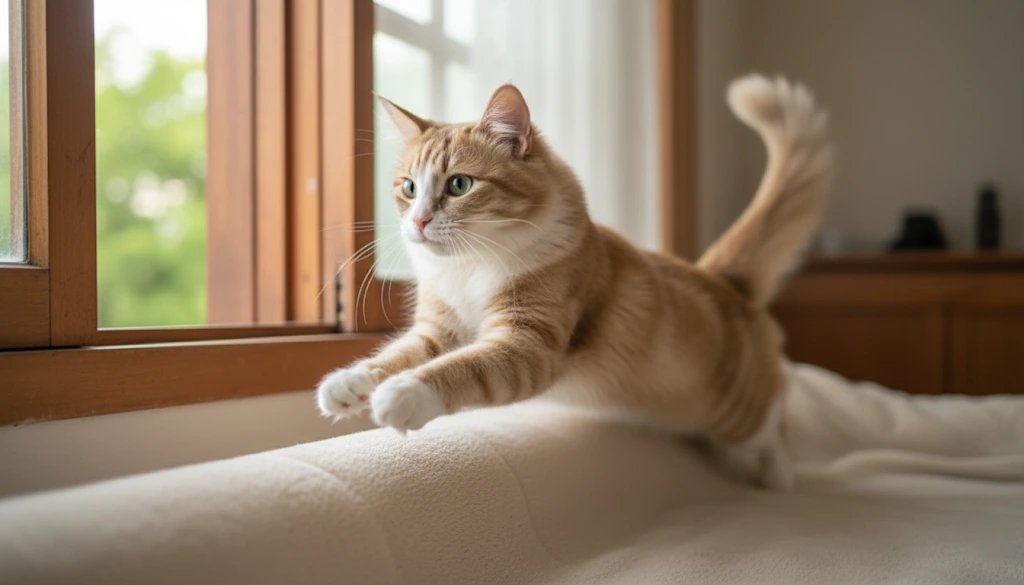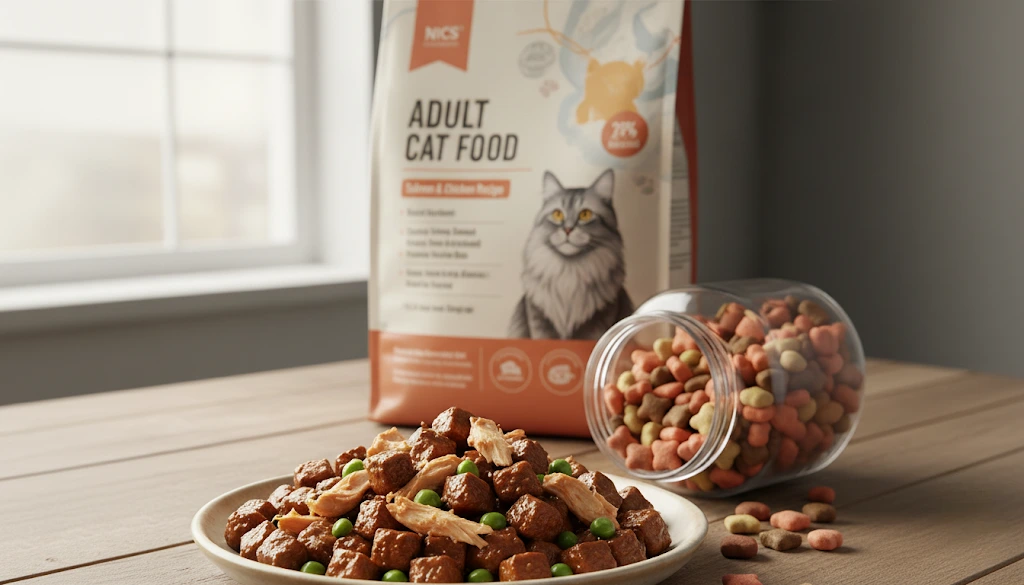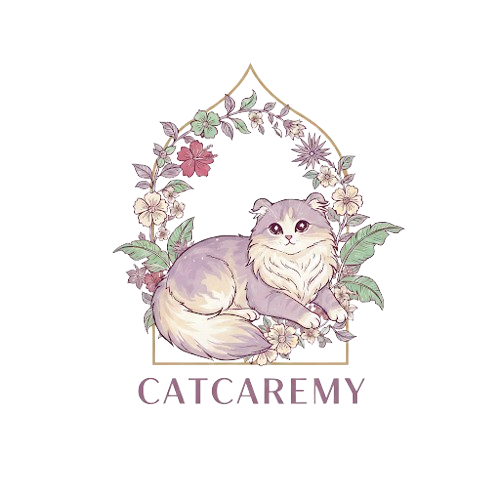
Feeding the right adult cat food is one of the most important decisions for keeping your indoor cat healthy. Cats spend most of their lives as adults (from around 12 months up to 10–12 years before they become seniors). Unlike kittens, they no longer need rapid growth nutrition, but they do need balanced meals to maintain muscle, prevent obesity, and support long-term organ health.
In Malaysia, where most pet households own cats, the demand for good-quality adult cat food has surged. A 2024 market report estimated that cat food contributes over 50% of the entire pet food industry revenue in Malaysia, reflecting just how central cats are in local households. Indoor cats especially rely on owners to make the right feeding decisions because they don’t hunt or self-regulate like outdoor cats.
This guide will help you answer Wet vs Dry Cat Food: Which Is Better for Indoor Cats?, understand Dry Cat Food Pros & Cons, explore Best Wet Cat Food Options, and learn how to apply a practical Dry Cat Food Guide.
Why Adult Cat Food Matters for Indoor Cats
Adult cats face three big challenges if their diet is not managed well:
- Obesity — Indoor cats exercise less, yet many dry foods are calorie-dense.
- Urinary tract issues — Common in Malaysia’s hot climate if cats eat only dry food with little water.
- Digestive sensitivity — Some cats react poorly to fillers or high-carbohydrate diets.
In fact, Malaysian veterinarians report that urinary crystals and kidney issues are among the most common health problems in adult indoor cats, often linked to low water intake and kibble-only diets.
Wet vs Dry Cat Food: Which Is Better for Indoor Cats?
There is no absolute winner. The choice depends on your cat’s health and your lifestyle. Let’s break it down.
Wet Cat Food Benefits
- Hydration boost — Wet food is ~70–80% water, supporting urinary and kidney health.
- Helps with weight control — Cats feel full faster, reducing overeating.
- Palatability — Malaysian cats often prefer gravy or jelly-style wet pouches.
Dry Cat Food Pros & Cons
Dry Cat Food Pros
- Affordable compared to wet food — many Malaysian families choose brands like Whiskas, Me-O, SmartHeart, Reflex.
- Easy storage in Malaysia’s humid climate if sealed properly.
- Convenient for owners with long work hours.
Dry Cat Food Cons
- Only ~10% moisture — risk of chronic dehydration.
- Higher carb content in cheaper brands.
- Some cats overeat when kibble is left out all day.
Mixed Feeding: The Balanced Option
Most Malaysian vets recommend mixed feeding — combining wet and dry food:
- Wet food meals for hydration and satiety.
- Dry food for convenience and dental texture.
Dry Cat Food Guide: What Malaysian Owners Should Know
If you choose to include dry food, here’s how to do it right:
- Look for protein-first formulas: Avoid kibbles where corn or rice dominate the ingredient list.
- Consider indoor-specific recipes: For example, Royal Canin Indoor Adult or IAMS Indoor Weight Control.
- Check calories per 100g: Budget kibbles like Me-O can be calorie-dense, while premium kibbles like Applaws Grain-Free are more balanced.
- Store safely: Malaysia’s humid weather means kibbles can spoil quickly — always reseal and use airtight containers.
Best Wet Cat Food Options in Malaysia
Wet food is especially important for indoor cats in Malaysia’s hot climate. Popular and widely available options include:
- Royal Canin Instinctive Pouches — formulated for adult maintenance.
- Fancy Feast Classic & Gravy Lovers (Purina) — premium yet available in major supermarkets.
- Whiskas Wet Pouches — budget-friendly, often found in Tesco, Jaya Grocer, and Aeon.
- Sheba Premium Cuts — marketed as affordable luxury, rising in popularity among urban cat owners.
- Applaws Natural Wet Food — high meat content, imported and stocked in Pet Lovers Centre.
💡 Price point insight: In Malaysia, wet food ranges from RM2–4 per pouch for Whiskas and SmartHeart, while premium brands like Royal Canin and Applaws cost RM6–10 per can/pouch. Many owners rotate between budget and premium to balance cost and quality.
Wet vs Dry vs Mixed — my recommendation
| Aspect | Wet | Dry | Mixed (my pick) |
|---|---|---|---|
| Hydration | Excellent (~70–80% water) | Poor (~5–12% water) | Best balance |
| Cost (Malaysia) | RM2–10/pouch/can depending on brand | RM15–150 / bag (size & brand) | Moderate (depends mix) |
| Convenience | Needs refrigeration after opening | Easy, long shelf-life if sealed | Flexible |
| Urinary health | Supports urine dilution | Risk if sole diet | Preventive when wet ratio ↑ |
(Price / availability references: local retailers — Watsons, Petico, Pet Lovers Centre.)
My stance: For most Malaysian indoor cats I recommend mixed feeding with at least 1 wet meal/day (or higher wet ratio for cats with urinary/CKD risk). Mixed feeding balances hydration and practicality.
Dry Cat Food Malaysia Guide: Owner’s Practical Checklist for Smarter Choices
Choosing the right kibble in Malaysia isn’t just about brand names — it’s about checking the details that matter. Here’s the checklist I personally use when buying dry food for my cats:
- Check the first three ingredients → Look for named meats (e.g., chicken, salmon, tuna). Avoid vague terms like “meat meal” or fillers like corn.
- Review guaranteed analysis & calories → Compare protein, fat, fiber, and kcal/100g. If the calorie count is high, measure portions strictly to prevent obesity.
- Match lifestyle needs → Indoor or weight-control formulas work better for sedentary cats. Local options include Royal Canin Indoor and IAMS Indoor.
- Think about Malaysia’s humidity → Always store kibble in airtight containers. Buy 2–4 kg bags unless you have sealed bulk storage.
- Say no to cheap fillers → Corn, wheat, and soy often mean more carbs, which can upset digestion in sensitive cats.

Cat Food Safety in Malaysia: Key Risks and How to Prevent Them
Malaysia’s pet market has its own challenges — from climate to counterfeit products. Here’s what I watch out for and how I deal with it:
- Counterfeit products online → Always buy from Shopee Mall, Lazada Flagship, or authorized retailers like Pet Lovers Centre and Watsons. Check seller ratings and distributor info before purchasing.
- Humidity & spoilage → I store kibble in airtight, opaque containers and avoid huge bags. For wet food, refrigerate after opening and finish within 48–72 hours.
- Urinary health risk (FLUTD) → If your cat shows signs like straining or bloody urine, increase wet food intake and see a vet. Malaysian clinics report urinary tract issues are a common diagnosis.
Practical Feeding Tips for Malaysian Indoor Cats
- Stick to portion control — many local owners free-feed kibble, which leads to obesity. Use measuring cups or digital scales.
- Hydration hacks — in Malaysia’s hot weather, invest in a cat water fountain or add extra water to wet food.
- Rotate proteins — cats can get bored with one flavor. Alternate between chicken, tuna, and salmon.
- Transition slowly — Malaysian cats fed mainly Whiskas may resist premium diets; mix gradually over 7–10 days.
- Watch for recalls and counterfeit products — always buy from official Shopee Mall or Lazada Flagship stores.
Sample Feeding Plan for a 4.5kg Malaysian Indoor Cat
- Morning (7am): 1 pouch of Whiskas wet (85g, ~80 kcal).
- Midday snack: 20g Royal Canin Indoor dry (~80 kcal).
- Evening (7pm): 1 pouch Fancy Feast (~90 kcal).
👉 Total ~250 kcal/day, adjusted if your cat is very active or sedentary.
Cost vs Quality — What Malaysian Owners Spend
- Budget feeders (RM100–150/month): Whiskas, Me-O, SmartHeart.
- Mid-range (RM200–300/month): Purina ONE, IAMS, Reflex.
- Premium (RM350–500/month): Royal Canin, Hill’s, Applaws, Sheba.
A single indoor cat in Kuala Lumpur costs on average RM250–350/month for food, depending on whether wet meals dominate. Many owners combine budget dry + premium wet to strike a balance.
Troubleshooting: Common Feeding Problems
- Picky eaters: Many Malaysian cats prefer gravy over paté. Start with Whiskas Jelly or Fancy Feast Gravy Lovers before transitioning.
- Overweight cats: Try Royal Canin Satiety Support or IAMS Indoor Weight Control formulas.
- Urinary issues: Switch to higher wet food ratio, consider Hill’s Prescription Diet c/d (often stocked in vet clinics).
- Bad breath: Don’t rely only on dry food for dental health; schedule annual dental checks.
Final Checklist for Malaysian Cat Owners
- Check your cat’s weight and body condition monthly.
- Decide: wet-first, dry-first, or mixed feeding based on hydration and cost.
- Pick from local brands (Whiskas, Me-O, SmartHeart) or premium (Royal Canin, Purina, Applaws, Sheba).
- Buy only from reputable retailers to avoid counterfeit.
- Consult your vet if your cat shows changes in appetite, urine habits, or weight.
Adult Cat Food FAQ for Malaysia: Storage, Hydration & Cost Tips
Why do indoor cats in Malaysia have higher risk of urinary problems compared to outdoor cats?
Malaysia’s hot, humid weather increases dehydration risk. Indoor cats that rely on dry kibble without enough water are more prone to urinary crystals and kidney issues. Outdoor cats sometimes self-regulate by hunting moisture-rich prey, but indoor cats can’t.
Is imported premium cat food really better than local brands in Malaysia?
Not always. Imported doesn’t mean superior — some mid-range local or regional brands (like Reflex or SmartHeart Gold) have decent protein-to-carb ratios. However, premium imports (Royal Canin, Hill’s, Applaws) are more consistent in ingredient sourcing and clinical trials. For cats with medical issues, vets still prefer international brands with proven formulations.
Can I mix Whiskas dry food with Royal Canin wet food?
Yes, mixed feeding is common in Malaysia to balance cost and nutrition. Just ensure portion control: Whiskas kibble tends to be higher in carbs, so balance it with high-protein wet food to avoid obesity.
Why does my cat refuse water even with a fountain?
Many Malaysian cats are adapted to wet diets in the wild (birds, lizards, small prey). Water bowls and fountains may not appeal. Adding extra water to wet food or serving ice cubes during hot days is often more effective.
How do I store cat food safely in Malaysia’s humid climate?
Dry food: Use airtight containers with silica gel packs; avoid storing in the kitchen where humidity is highest.
Wet food: Opened cans/pouches must be refrigerated and used within 24 hours; transfer leftovers to glass containers, not the pouch itself.
Pro tip: Many Malaysian owners freeze portioned wet food and thaw daily to save cost and reduce spoilage.
What is the average monthly cost of feeding one indoor cat in Kuala Lumpur?
Budget feeding: RM120–180 (mainly Whiskas/Me-O).
Balanced feeding (mix budget dry + premium wet): RM250–300.
Premium feeding only: RM400–500+.
Urban households typically spend ~RM280/month per indoor cat, higher than rural averages.
Do cats in Malaysia need different diets compared to Europe or the US?
Yes, mainly due to climate and lifestyle differences. Indoor cats in Malaysia face dehydration risk year-round, unlike in cooler climates. Diets should prioritize hydration and weight control over high-calorie bulking formulas.
How do I know if cat food on Shopee or Lazada is counterfeit?
Price too low (e.g., Royal Canin pouch at RM3 when retail is RM7).
Packaging with blurry fonts or missing Malay import stickers.
Seller not listed as Shopee Mall or Lazada Flagship.
Many Malaysian vets warn that counterfeit kibbles often cause sudden diarrhea or refusal to eat.
Resources & Links
- Veterinary nutrition advice: [Cat nutrition guide]
- Related guides: [Grain-Free Cat Food] [Kitten Feeding Guide]

[…] Wet vs Dry Cat Food: Which Is Better for Indoor Cats? […]